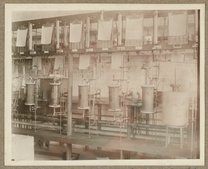Reaction bombs for testing of catalysts
- Circa 1928
General view of reaction bombs used at the U.S. Department of Agriculture's Fixed Nitrogen Research Laboratory to test catalysts at 100 atmospheres of pressure. Numbers are visible on the exterior of the various containers. Per this process, catalysts were introduced into the sealed containers containing a particular substance. The containers were then heated to a reaction temperature for a predetermined amount of time in order to test the activity of the catalyst for a particular chemical reaction.
The Fixed Nitrogen Research Laboratory (F.N.R.L.) was established at American University in 1919 under the directorship of Arthur B. Lamb. Initially part of the War Department, the F.N.R.L. was the successor to several wartime initiatives to develop a secure domestic supply of nitrate compounds necessary for the manufacture of explosives during World War I. With a staff of about 110 individuals, including 35 to 50 chemists, the F.N.R.L. focused on the manufacture, production, and development of products of atmospheric nitrogen, including munitions and fertilizers.
| Property | Value |
|---|---|
| Format | |
| Genre | |
| Extent |
|
| Subject | |
| Rights | No Known Copyright |
| Credit line |
|
Institutional location
| Department | |
|---|---|
| Collection | |
| Physical container |
|
View collection guide View in library catalog
Related Items
Cite as
“Reaction Bombs for Testing of Catalysts,” circa 1928. Travis P. Hignett Collection of Fixed Nitrogen Research Laboratory Photographs, Box 1. Science History Institute. Philadelphia. https://digital.sciencehistory.org/works/9c67wm93v.
This citation is automatically generated and may contain errors.






